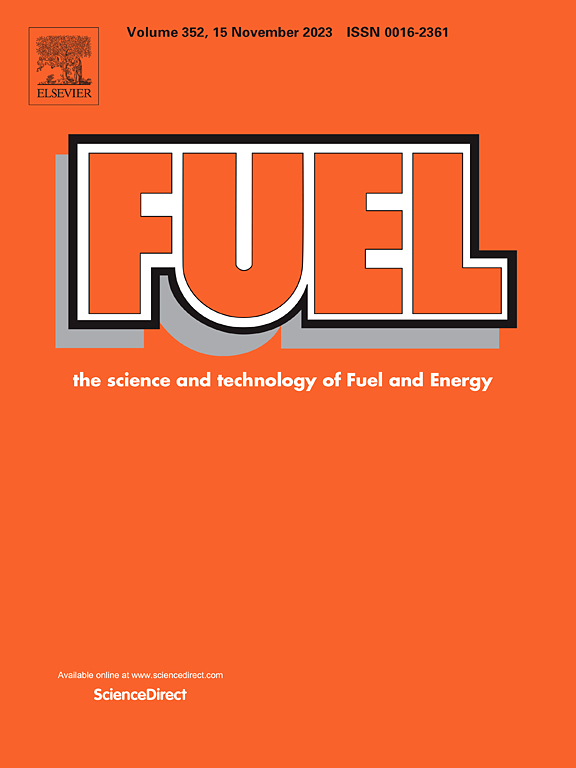mof衍生的氮配位铁单原子:一种有前途的被动直接乙醇碱性燃料电池ORR电催化剂
IF 6.7
1区 工程技术
Q2 ENERGY & FUELS
引用次数: 0
摘要
本研究提出了一种用于氧还原反应(ORR)的新型电催化剂,其特征是单原子铁掺杂氮(Fe-Nx)嵌入碳基框架中。电催化剂来源于双金属分子筛咪唑框架(Zn/Fe-BZIF),利用金属有机框架(MOFs)的高表面积、可调节的配位环境、稳定性和成本效益。铁的掺入显著提高了起爆电位,使该材料成为高性能ORR应用的有前途的候选材料。为了达到原子级分散和防止团聚,采用双溶剂法将铁盐前驱体包封在ZIF-8的亲水性孔隙中。该方法保证了精确集成和优化电催化剂效率。热解后,Fe-s/NC催化剂在碱性介质中表现出优异的ORR活性和稳定性,超过了商用Pt/C。该催化剂对氧直接4e还原为水具有很高的选择性,起始电位(Eonset)为1.03 VRHE,半波电位(E1/2)为0.93 VRHE。超过40000秒的计时电流测试,它保持了90%的初始电流密度。此外,该电催化剂在直接乙醇碱性燃料电池(DEAFC)和低乙醇浓度下的传感器应用中表现出了良好的性能。在空气中,它在0.320 V时的开路电压(OCV)为0.920 V,峰值功率密度(Pmax)为14.7 mW cm - 2;在氧气中,它在0.346 V时的开路电压(OCV)为0.946 V,峰值功率密度(Pmax)为19.3 mW cm2。本研究介绍了Fe-s/NC作为一种新型催化剂,以提高被动聋哑阴极的电催化性能。本文章由计算机程序翻译,如有差异,请以英文原文为准。
MOF-derived nitrogen-coordinated iron single atoms: A promising ORR electrocatalyst for passive direct ethanol alkaline fuel cells
This study presents a novel electrocatalyst for the oxygen reduction reaction (ORR), featuring single-atom iron-doped nitrogen (Fe-Nx) embedded in a carbon-based framework. The electrocatalyst was derived from a bimetallic zeolitic imidazole framework (Zn/Fe-BZIF), leveraging the high surface area, tunable coordination environments, stability, and cost-effectiveness of metal–organic frameworks (MOFs). Iron incorporation significantly enhanced the onset potential, positioning the material as a promising candidate for high-performance ORR applications. To achieve atomic-level dispersion and prevent agglomeration, the double solvent method was utilized, encapsulating the iron salt precursor within the hydrophilic pores of ZIF-8. This method ensured precise integration and optimized electrocatalyst efficiency. Following pyrolysis, the Fe-s/NC catalyst exhibited outstanding ORR activity and stability in alkaline media, surpassing commercial Pt/C. The catalyst demonstrated high selectivity for the direct 4e− reduction of oxygen to water, achieving an onset potential (Eonset) of 1.03 VRHE and a half-wave potential (E1/2) of 0.93 VRHE. Over 40,000 s of chronoamperometric testing, it maintained 90% of its initial current density. Furthermore, the electrocatalyst showed promising performance in a direct ethanol alkaline fuel cell (DEAFC) and in sensor applications at low ethanol concentrations. In air, it achieved an open-circuit voltage (OCV) of 0.920 V with a peak power density (Pmax) of 14.7 mW cm−2 at 0.320 V, and in oxygen, it reached an OCV of 0.946 V with Pmax of 19.3 mW cm2 at 0.346 V. This research introduced Fe-s/NC as an innovative catalyst to enhance cathode's electrocatalytic performance in passive DEAFCs.
求助全文
通过发布文献求助,成功后即可免费获取论文全文。
去求助
来源期刊

Fuel
工程技术-工程:化工
CiteScore
12.80
自引率
20.30%
发文量
3506
审稿时长
64 days
期刊介绍:
The exploration of energy sources remains a critical matter of study. For the past nine decades, fuel has consistently held the forefront in primary research efforts within the field of energy science. This area of investigation encompasses a wide range of subjects, with a particular emphasis on emerging concerns like environmental factors and pollution.
 求助内容:
求助内容: 应助结果提醒方式:
应助结果提醒方式:


